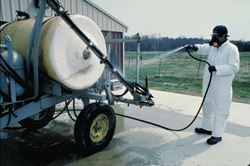|
Spray Equipment Cleanup Saves Time And Money
DR. LEE TOWNSEND
LEXINGTON, KY.
Time spent in sprayer clean-up can reduce maintenance downtime and even cause costly crop injury.
If you will be applying the same product the next day, then flushing the system with water may be sufficient. That will wash out accumulations of wettable powder, dry flowable, water dispersible granule, and flowable formulations before they can dry and harden. Doing this can reduce the chance of problems with partially clogged strainer screens and reduced spray flow through hoses and nozzles. In addition, some pesticide residues can corrode metal, plug hoses, or damage pumps and valves if they are not removed immediately after use.
A more thorough cleaning is necessary to avoid potential injury when switching products or crops.
Residues in tanks and hoses may affect the effectiveness of the new products or cause compatibility problems. In some cases, solvents in emulsifiable concentrates may dissolve incompletely removed product residues. Check product labels for specific instructions.
Selecting a Cleaning Location
Select a location to clean the sprayer so any spilled rinsate will not contaminate water supplies, streams, crops, or other plants. You will also want a site where puddles will not be accessible to children, pets, livestock, or wildlife. If this is not available, catch or contain the rinsate and spray the rinse water or the cleaning solution on a site and in a manner consistent with the labeled use of the pesticide product.
Cleaning Agents
After the equipment is empty, clean both the inside and the outside thoroughly, including nozzles or hopper openings. Several commercial compounds will aid in tank cleaning. These can neutralize and remove pesticide residues, remove mineral deposits and rust, and leave a protective film on tank walls to help prevent corrosion
• Tank-cleaning agents penetrate, loosen, and dissolve pesticide residues so they can be removed through dilution. In some cases, the agent will provide deactivation or decomposition of the herbicide.
• Commercial tank cleaners are recommended on many product labels and help remove water and oil soluble herbicides.
• Household ammonia, a commonly recommended cleaning agent, is effective at penetrating and loosening deposits and residues in the spraying system. Although ammonia does not decompose herbicides, it increases the solubility of some herbicides by raising pH.
• Chlorine bleach can decompose residues of most sulfonylurea and other herbicides into inactive compounds. However, some tank-mix partners may inhibit the decomposition. Use chlorine bleach carefully. It can combine with fertilizers containing ammonia to produce dangerous chlorine gas, which is irritating to the eyes, nose, throat, and lungs. Also, rinsate containing chlorine bleach is not labeled for application to crop land.
Cleaning and Rinsing
Special tank-cleaning nozzles are available to clean the interior walls of spray tanks. For all application scenarios, make sure the entire spray system is cleaned, not just the tank. This is especially true for commercial row crop boom sprayers. Besides the spray tank, problem spots for pesticide contamination include:
• the inductor
• plumbing, which includes valves and hoses
• filters and screens
• boom segments
• nozzle bodies
• nozzles and screens.
When possible, thoroughly rinse equipment with a strong water-detergent solution (8 to 16 ounces of detergent in 30 to 40 gallons of water). Allow the water-detergent solution to circulate through the system for several minutes. Remove nozzles and screens, then flush the sprayer system twice with clean water. Some pesticide labels may require triple rinsing to rid the spray system of any possible pesticide contamination. Regardless of how the spray system is cleaned, make sure all visible deposits are removed.
Results of Poor Cleanup
Sloppy cleanup practices are one of the main causes of equipment failure or malfunction. Pesticides allowed to dry in the application equipment tend to clump and stick and cannot be easily removed. These deposits may eventually dissolve into the spray solution. Thus, improper cleanout may lead to contamination of tank mixes and damage to susceptible crops. ∆
DR. LEE TOWNSEND: Extension Entomologist, University of Kentucky

Figure 1. Sprayer cleanup
Photo: USDA
|
|